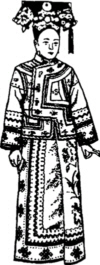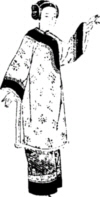Chapter 51 Section 4 General Women's Clothing
There are two types of women's clothing in the Qing Dynasty, Manchu and Han.Manchu women generally wear long gowns; Han women still mainly wear tops and skirts.After the middle Qing Dynasty, they also imitated each other.
Manchu women's robes have a round neck, a large placket, and flat cuffs, which are long enough to cover their feet.The outside is often covered with a short or long waistcoat.The robes of aristocratic women are mostly decorated with dragons and pythons, and generally silk embroidery.Sleeves, skirts, skirts, etc. are inlaid with various colored ribbons or colored teeth.Manchu women's cheongsam is also popular with "big sleeves", the sleeves are longer than the hands, and the lower half of the sleeves are embroidered with various patterns of different colors from the sleeves to show another style and beauty.The separation of collar and gown was another feature of cheongsam in the early Qing Dynasty.Women also need to wear a collar when wearing a cheongsam.This is a folded silk ribbon about two inches wide. It is wrapped around the neck, with one end tucked in the placket and the other hanging down, like a scarf.During the Tongzhi and Guangxu periods (1862-1908 A.D.), leading robes and coats gradually appeared, and even waistcoats also had collars.The height of the collar is also constantly changing.After the Republic of China, there have been no gowns or gowns without a leader.This kind of gown later evolved into the main clothing of Han women - cheongsam.
Manchu women's shoes are very distinctive.With wood as the bottom, the sole is very high, similar to today's high heels, but the high heel is in the middle of the shoe.It is generally one or two inches high, and later it will increase to four or five inches. It is wider at the top and bottom, and the middle is thin and round, like a flowerpot, so it is called "flowerpot bottom".Some bottoms are chiseled into a horseshoe shape, so they are also called "horseshoe bottoms".Most of the vamps are made of satin, embroidered with patterns, and the soles are painted with white powder. Women from rich and noble families also inlaid gems around the heels.This kind of sole is extremely strong, and often the shoe has been broken, but the sole can still be reused.Brides and young women wear more, and the general girl starts to wear high bottoms when she is 13 or 14 years old.In the late Qing Dynasty, wearing a long robe and wearing flower pot sole shoes has become the dress in the Qing palace.

manchu women's clothing
Han women's clothing changes less than men's clothing, and generally wears capes, jackets, and skirts.The cloak is an overcoat, similar to a men's gown, with a pair of breasts, large sleeves, and knee-length bottom.Capes have low collars and some are embellished with various jewels.Inside is the upper jacket and lower skirt.In the early days, the skirts still preserved the legacy of the Ming Dynasty. There were styles such as phoenix-tailed skirts and Yuehua skirts. Later, with the passage of time, skirt styles continued to develop, and many new skirt styles were created, such as a kind of "bounce ink skirt", also called "ink flower skirt". ", is to print black flowers on light-colored silk and satin with bullet-ink technology. The color is simple and elegant, and it is very popular among women.In the future, some skirts will be decorated with streamers, some will be tied with small bells under the skirt, and some will be embroidered with water patterns on the bottom of the skirt.During the Tongzhi period (1862-1874 AD), the fashionable "fish scale pleated skirt" was a development of the traditional pleated skirt, that is, the pleats of the skirt were cross-connected with silk threads, and the skirt was unfolded like fish scales, novel and colorful. .The matching of skirts and shirts also changes from time to time.At the beginning of the Qing Dynasty, it still followed the style left over since Jiajing in the Ming Dynasty. The jacket was longer and the skirt was shorter, not covering the feet; Big, especially educated women often wear small round jackets and long pleated skirts. The colors are coordinated, and they look dignified and elegant, delicate and elegant.In the late Qing Dynasty, it was popular in the south to wear long trousers without skirts. Most of the trousers were made of silk with patterns embroidered on them.In addition, there are vests, which can reach below the knee and are mostly trimmed.Some of the leather clothes worn in winter expose the vellus hair inside, which is called "chufeng".After the mid-Qing Dynasty, it was popular for women to wear cloaks in winter, as well as western-style overcoats, as well as cloud shoulders from the Ming Dynasty.
An important feature of women's clothing in the Qing Dynasty was the extensive use of lace.The use of lace has a history of more than 2,000 years in our country. It was initially added to easy-to-wear places such as necklines, cuffs, skirts, and hems. Later, it became a kind of decoration and became popular.In the late Qing Dynasty, some garments were trimmed with lace, up to several layers.

woman in tunic
There were many changes in the style of clothes in the Qing Dynasty.During the Tongzhi and Guangxu years, men's and women's clothing services were still extensive, and the sleeves were more than one foot wide.And after the Sino-Japanese War, the invasion of the Eight-Power Allied Forces, repeated foreign aggressions, government changes, clothing and daily life, many reforms to the old system.The short gown with narrow sleeves is good for arming, and it is relatively novel and increasingly fashionable.By the end of the Qing Dynasty, the advancement of textiles and science and technology made the materials and patterns of clothing more abundant and diverse.Clothing materials mainly include damask, Luo, brocade, silk, silk, kudzu, quilted yarn, flash satin, feather yarn, serge satin, Zhang velvet, sheared velvet, fine cloth and so on.In addition to bright yellow, golden yellow, and fragrant colors that ordinary people cannot use, sky blue, rose purple, deep crimson, mud gold, cherry red, sorghum red, light pink, light gray, brown, etc. are the colors that most people like.The pattern is not only beautiful in shape, but also contains deep meaning.The dragon, python, phoenix, and Zhai used exclusively by the ruling class are majestic and solemn.The general characters of Fu, Lu, and Shou, the eternal wealth and wealth, the group crane, the group flower, the eight treasures, the eight auspicious signs, as well as the patterns of Dharma wheel, treasure cover, sword, bat, ruyi, swastika, cloud board, flower basket, bamboo tube, etc. , all contain good wishes such as good luck and good luck.In the late Qing Dynasty, many realistic patterns appeared, such as longevity peach, magpie, cloud crane, peony, bergamot, pomegranate, plum, orchid, bamboo, chrysanthemum, etc. Various patterns reflect people's increasingly realistic spirit in the war-torn era.

manchu women's clothing

woman in tunic
